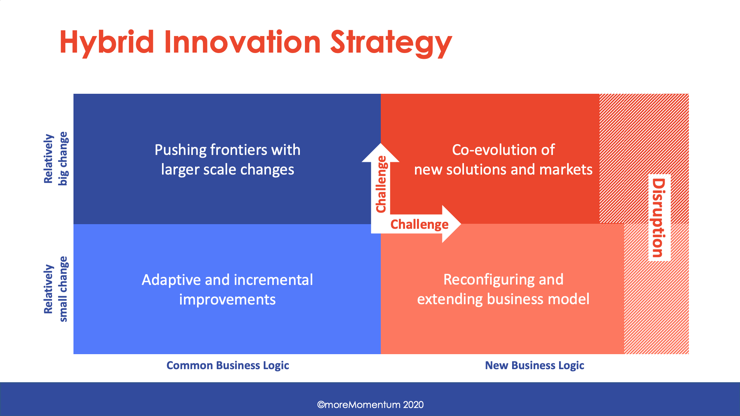How to Build a Growth-Driven Service Innovation Portfolio
A balanced mix of sustaining, adjacent, and transformational innovations is essential for long-term success in B2B manufacturing, but many companies...
4 min read
Jan van Veen
Sep 17, 2019 12:10:00 PM

Burning Platforms are bad for innovation and change because they cause higher risks for failure and do not drive fluid, continuous innovation.
Burning Platforms are bad for innovation and change because they focus on an urgent necessity to change. This triggers a defensive attitude causing higher risks for failure, has a lot of collateral damage and does not drive fluid, continuous innovation to thrive in a rapidly changing world.
Often I hear from business leaders that their colleagues are not that open to innovate and change. The overall performance is good and there is no clear threat visible. There is no “sense of urgency” and no “burning platform” for innovation and change. A common response is to either wait until the situation gets worse or to construct a (mini)crisis to increase and maintain a burning platform.
However, the question is:
In this article I will share 5 reasons why a burning platform is bad for sustainable innovation and change in rapidly changing industries.
Typically, the trends which create threats or opportunities develop a long while before becoming an obvious burning platform.
At early stages, there are already the first weak signals for potential trend. At this time, it is still hard to accurately predict what will happen and when. Maybe different weak signals contradict each other. The majority of the manufacturers does not recognise or otherwise ignores these weak signals.
After some time, we see the first competitors moving, but actually also struggling to address the threats or opportunities successfully. Their initiatives seem to be failing. As a result, the majority still waits.
Once the leading competitors are having their first successes and the trends and impact have become evident, there is a clear burning platform. But now, the leading competitors have learned and built capabilities so they can scale up. The lagging majority is still trying to find the right questions, let alone the right answers. They are dropping behind the leading pack in their industry.
They are simply too late.
The urgent situation of a burning platform means there is a critical situation which requires a rapid response and rapid results. The topic is becoming increasingly dominant in the daily activities of everyone in the organisations. All hands on deck!
The burning platform starts distracting attention from the daily work of running the business. As a result, the overall performance will suffer more and longer than would have been the case if the urgent critical situation would have been prevented by innovation and change at a much earlier stage.
In general, a necessity to change – the burning platform – will create higher stress levels which affect attitude and behaviour of employees towards the upcoming change. The more critical and urgent the need for change, the bigger the chances for stress levels. This triggers negative and defensive reactions like fight, flight or freeze.
Too often, we see high stress levels result in internal fights, pointing fingers, pushing problems to other teams and the best talents moving to other companies.
Maybe, these negative sentiments can be transformed into a more positive and bonding attitude within teams for a while, but not for long time.
When solutions require deeper analysis, it is important that teams are creative, open to new types of solutions and that they collaborate with other teams or departments.
However, the defensive fight, flight or freeze behaviour mentioned above, triggers short-term reactive thinking and symptom-fighting. This blocks constructive and creative thinking.
The high level of stress (caused by a strong burning platform) increases the risks of not seeing the real problems or opportunities, not finding the right solutions and not doing what it really takes to get the results.
During the first attempt at implementing a new solution, you can expect hiccups. Instead of experiencing this as a failure, everyone should see this as an opportunity to learn. They should be able to have a constructive and forward-looking dialogue to collectively understand why it is not working yet and what interventions are required to get it right.
With a flight, fight or freeze attitude, people will blame others or the conditions, find reasons to justify the disappointing results and give up.
For sure, we know about compelling stories where companies successfully pivoted their business during a crisis, like IBM. However, there are many more examples of companies which miserably failed during a crisis and did not survive.
The better option is what leading and dynamic manufacturers do very well: they rally their employees, their clients and their partners with a strong and compelling purpose, which makes continuous innovations and change the natural, logical and compelling thing to do.
A good example is Philips Healthcare. Everyone is committed to transforming healthcare by offering and developing integrated solutions (hardware, software, data and services) for people to live healthier by
Tesla is a good example too. Their mission is to accelerate the transition of sustainable energy and transportation with electric vehicles, better batteries and solar panels.
A strong and compelling direction will be more rewarding for everyone, lead to sustainable success of the business and reduce the chances of entering periods of critical decline of performance.
And, it will avoid you and your colleagues being stuck on a burning platform.
In essence, if there are compelling reasons and not too many obstacles, people will change and drive innovation to improve. They do not need a crisis or burning platform to change. After all, that is the only reason the world is changing so rapidly.
However, too many organisations do a bad job in providing compelling reasons and a good job in creating obstacles. That is the reason organisations struggle to keep up the high pace of the changing world.
Leading, dynamic and innovative companies set themselves apart by creating a great environment for collaborative change and innovation. Part of that is maintaining a clear and compelling purpose, direction and strategic intent.
In today’s complex and disruptive world, it is mission-critical to enable everyone in your organisation to drive continuous, high-pace and complex innovations and change.
The common practice of creating a burning platform is bad for innovation and change.
A much better alternative is to build and maintain a compelling purpose for everyone to be proud of and to work on.
If you would like to take next steps, I would recommend you to;
I am confident that applying the recommendations above will bring you actionable insights for you and your teams – if not for the business as a whole. Good luck!
Subscribe for the our Impulse Letter
With regular updates about service news, trends and best practices.

A balanced mix of sustaining, adjacent, and transformational innovations is essential for long-term success in B2B manufacturing, but many companies...

Navigating innovation in B2B manufacturing is essential for transforming services into strategic business lines. Adopting tailored methodologies for...

Driving your service innovation strategy is crucial for swift and effective transformation in B2B manufacturing. By aligning with corporate goals,...